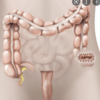Gastrointestinal Cancers Flashcards
(113 cards)
Define cancer
A disease caused by an uncontrolled division of abnormal cells in a part of the body
Define primary cancer
Cancer arising directly from the cells in an organ
Define secondary cancer/metastasis
Cancer spread to another organ, directly or by other means (blood or lymph)
List the 3 main types of cells/tissues highly susceptible to cancer in the GI tract
Epithelial cells (e.g. squamous and glandular epithelial cells)
Neuroendocrine cells (e.g. enteroendocrine cells + Interstitial cells of Cajal)
Connective tissue (e.g. adipose tissue + smooth muscle)
List 4 cells of the GI tract susceptible to becoming cancerous
Squamous cells
Glandular epithelial cells
Enteroendocrine cells
Interstitial cells of Cajal
Smooth muscle
Adipose tissue
Which cancer of the GI tract is derived from squamous epithelial cells?
Squamous cell carcinoma (SCC)
Which cancer of the GI tract is derived from glandular epithelium?
Adenocarcinomas
Which cancer of the GI tract is derived from enteroendocrine cells?
Neuroendocrine tumors (NETs)
Which cancer of the GI tract is derived from interstitial cells of Cajal?
Gastrointestinal stromal tumors (GISTs)
Which cancer of the GI tract is derived from smooth muscle?
Leiomyoma/Leiomyosarcoma
Which cancer of the GI tract is derived from adipsoe tissue?
Liposarcoma
Where are GI neuroendocrine tumors located?
Can be located anywhere along the GI tract from the oesophagus to the rectum
Squamous cell carcinomas tend to develop in which portion of the oesophagus? Explain why
Upper 2/3rds of the oesophagus
The type of epithelium lining the oesophagus above the Z-line is stratified squamous epithelium
What is a common cause of squamous cell carcinoma oesophageal cancers?
Acetaldehyde pathway
[ACETALDEHYDE PATHWAY -EtOH – alcohol dehydrogenase (ADH) – oxidized acetaldehyde – aldehyde dehydrogenase (ALDH) – oxidized - acetate]
Squamous cell carcinoma is a more common oesophageal cancer in which type of countries?
Countries in the less developed world
Adenomacarcinomas are derived from which type of cells?
From metaplastic columnar epithelium
Adenocarcinoma oesophageal cancers occur mainly in which part of the oesophagus and why?
Occur in distal third of the oesophagus
Below the Z-line, the epithelium is simple columnar and these cells can develop into adenocarcinomas

Oesophageal adenocarcinomas are related to which condition?
Related to acid reflux
Oesophageal adenocarcinomas is more common than squamous cell carcinomas in which types of countries?
Countries of the more developed world
Briefly describe the transition of reflux into oesophageal cancer
Reflux leads to oesophagitis due to inflammation
Chronic inflammation can lead to metaplasia, resulting in presence of Barret’s Oesophagus
There is a chance overtime that metastatic epithelial cells present in Barret’s oesophagus patients can display neoplastic changes, resulting in formation of adenocarcinoma
N.B. Inflammation —> Metaplasia —> Neoplasia

What percentage of the UK population experiencing oesophagitis is caused due to GORD?
30% of UK population experiencing oesophagitis
What percentage of GORD population will end up developing Barret’s Oesophagus?
5% of GORD population
What is the likelihood of someone with Barret’s oesophagus developing adenocarcinoma?
Barrett’s lifetime risk of cancer - 0.5-1%/ year.
In comparison to the general population what is the fold risk of developing cancer in patient’s with Barret’s oesophagus?
30-100 fold risk of cancer























